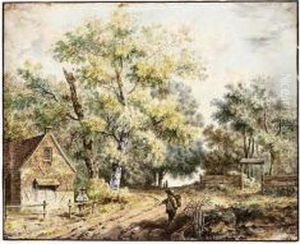Wouter Joannes Van Troostwyk Paintings
Wouter Johannes van Troostwijk was a Dutch artist, known primarily for his contributions to the Dutch art scene as a painter, draftsman, and etcher. Born on September 10, 1739, in Amsterdam, he came of age in a period when Dutch art was characterized by its attention to detail, its interest in capturing the play of light and shadow, and its focus on scenes from everyday life as well as landscapes.
Van Troostwijk's artistic journey was largely influenced by the Dutch Golden Age of painting, although he was active in a later period. He was particularly inspired by the works of Dutch masters such as Rembrandt van Rijn, whose use of chiaroscuro and dramatic lighting effects can be seen echoed in Van Troostwijk's work. However, he was also receptive to influences from contemporary European art movements of his time.
His oeuvre includes a range of subjects from landscapes and cityscapes to still lifes and genre scenes. Van Troostwijk was not only skilled in oil painting but also demonstrated considerable talent in drawing and printmaking. His etchings are known for their technical skill and ability to capture the dynamic qualities of his subjects.
Despite his talent, Wouter Johannes van Troostwijk did not achieve significant fame during his lifetime. His work was appreciated by connoisseurs and collectors but did not gain the widespread recognition that some of his contemporaries enjoyed. Today, his paintings can be found in various Dutch museums, and he is recognized as a skilled artist whose work provides insight into the Dutch art world of the late 18th and early 19th centuries.
Wouter Johannes van Troostwijk passed away on August 29, 1810, in his hometown of Amsterdam. Though his name may not be as well-known as some of his Dutch predecessors, his contributions to the Dutch artistic heritage continue to be appreciated by art historians and enthusiasts alike.
